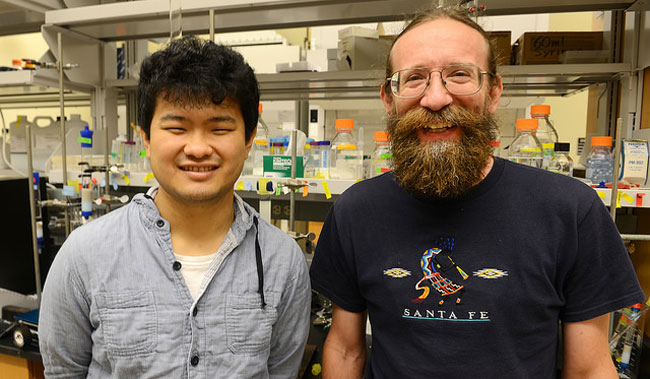OSU researchers report use of novel technique to measure changes in protein molecule
Thursday, September 3, 2015

An ongoing research collaboration between Oklahoma State University and Japanese scientists has resulted in the publication of a study in an internationally respected chemistry journal that confirms for the first time theories about a novel spectroscopic technique to measure molecular changes in a protein. The paper, co-written by faculty at OSU and Saga University in Japan, may lead to increased understanding of the structure of proteins and other biomolecules.
Using the spectroscopic technique known as Raman optical activity (ROA), the scientists were able to measure structural distortions in light-absorbing molecules within a photoreceptor protein, said Wouter Hoff, OSU professor of microbiology and molecular genetics and a study co-author.
“This result fully opens the door to future analysis of protein function and enzyme action using pre-resonance ROA spectroscopy,” said Hoff.
The research was conducted with Japanese scientists, including Hoff’s chief collaborator, chemistry professor Masashi Unno with Saga University. Also involved is a Saga graduate student currently working with Hoff at OSU. Their study was published this summer in Angewandte Chemie International Edition, a leading chemistry journal published in Germany.
ROA spectroscopy is a technique that measures the difference in intensity between left and right polarized Raman scattered light, which can provide extremely accurate information about molecular structures. The technically challenging method has been used to study biomolecules like enzymes, nucleic acid and viruses.
Hoff and Unno worked together for two years to develop techniques to use ROA to understand the structure of proteins. The chemists are interested in what happens when a light-absorbing molecule in a photoreceptor, in this case the photoactive yellow protein (PYP), is changed by light. When it absorbs light, the PYP molecule is structurally deformed, which happens in a picosecond, or a trillionth of a second, according to Hoff. The trick is accurately measuring these changes happening at a molecular level and so quickly.
The study provided the first experimental evidence that use of one technique, resonance ROA spectroscopy, actually eliminates structural information, which scientists had predicted. But by using pre-resonance ROA, the spectroscopic signals are enhanced without information loss.
“One of the complications of ROA is that the signals are so weak,” said Hoff. “But pre-resonance ROA yields signal enhancement while retaining the structural information. And the exciting thing is that you can measure distortions to the light-absorbing molecule.”
Hoff said collaboration was essential to achieving the study results. Unno’s lab provides unique expertise in ROA spectroscopy measurements and quantum chemical calculations needed to analyze the ROA spectra while Hoff’s expertise is in preparing protein samples and the biological interpretation of the results. This is the second paper Unno and Hoff have jointly published. Their research has shown how using this complex method provides a key to future research into biomolecular structures using ROA.
“Are the distortions important or not? Many scientists think that they are, particularly in the very first steps in light detection and vision, but it has been hard to demonstrate this. ROA is a powerful new tool for those types of questions,” he said.
The collaboration between Unno and Hoff includes the hosting at OSU of Saga University graduate student Shojiro Haraguchi, who is currently working with Hoff to design future ROA experiments. Haraguchi, first author of the paper published in Angewandte Chemie, is spending 6 months at OSU made possible by a Saga University chemistry fellowship.
“Collaboration is so important because it allows for the exchange of technical capabilities and an exchange of ideas,” Hoff said.
The next steps in their research include developing improved techniques to measure the changes occurring in the photoreceptors when exposed to light. One technique is to conduct the experiment at extremely low, or cryogenic, temperatures.
“This would be the first cryogenic ROA,” said Hoff. “That’s extremely difficult, but not impossible, and promises to help understand the very first events that allow proteins to detect light”.
PHOTO: https://www.flickr.com/photos/ostatenews/albums/72157657638303320
